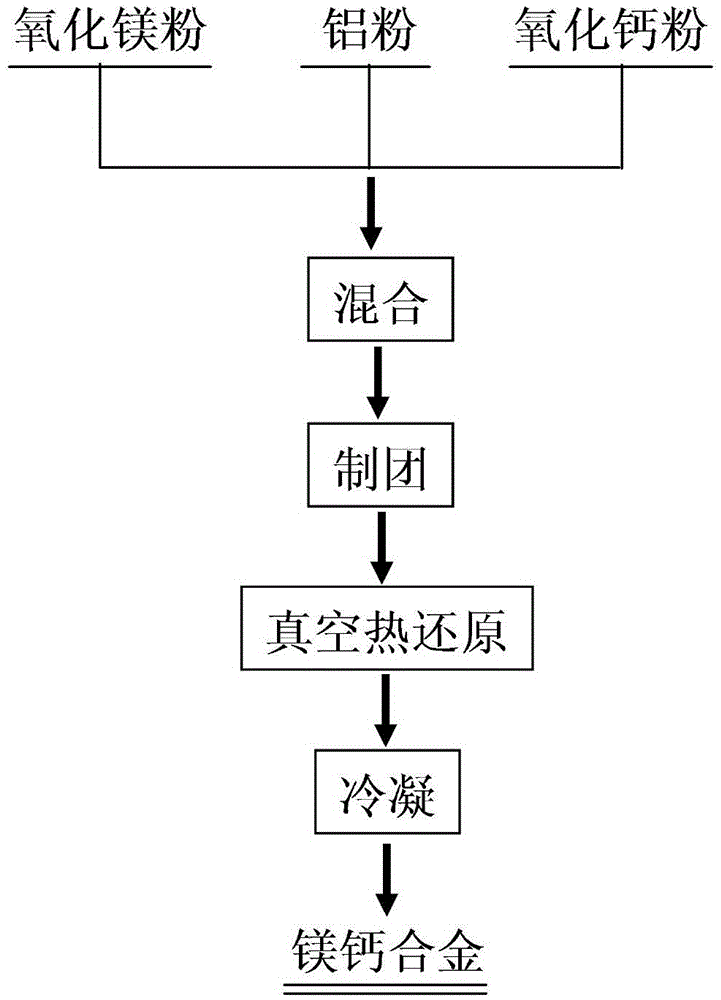Method for preparing magnesium-calcium alloy through aluminothermic reduction
A magnesium-calcium alloy and thermite technology, applied in the field of metallurgy, can solve the problems of short process, intense secondary reaction, unsuitable collection of products and product purity, and achieve the effects of low cost, high production efficiency and high product purity
- Summary
- Abstract
- Description
- Claims
- Application Information
AI Technical Summary
Problems solved by technology
Method used
Image
Examples
Embodiment 1
[0026] The method for producing magnesium-calcium alloy through thermite reduction comprises the following steps:
[0027] Step 1, MgO powder with a particle size of 61 μm, CaO powder with a particle size of 61 μm and Al powder with a particle size of 175 μm, MgO powder: CaO powder: Al powder=100:87:46 are mixed evenly by mass ratio;
[0028] Step 2, using a press to press the mixed material into an agglomerate with a thickness of about 4mm under a pressure of 100MPa;
[0029] Step 3, put the agglomerate into the reduction tank and vacuumize to 1Pa, then keep the reduction tank at 1150°C for 6 hours to reduce magnesium oxide and calcium oxide into magnesium vapor and calcium vapor;
[0030] Step 4, after the magnesium vapor and the calcium vapor are condensed, a magnesium-calcium alloy with a calcium content of 2.5-3.5wt.% is obtained in the crystallizer.
[0031] The process flow chart of the method for producing magnesium-calcium alloy by thermite reduction of the present e...
Embodiment 2
[0033] The method for producing magnesium-calcium alloy through thermite reduction comprises the following steps:
[0034] Step 1, select the MgO powder with a particle size of 74 μm, the CaO powder of 74 μm and the Al powder of 125 μm, and mix evenly by mass ratio as MgO powder: CaO powder: Al powder=100:96:48;
[0035] Step 2, using a press to press the mixed material into an agglomerate with a thickness of about 6mm under a pressure of 80MPa;
[0036] Step 3, put the agglomerate into the reduction tank and vacuumize to 4Pa, then keep the reduction tank at 1200°C for 5 hours to reduce magnesium oxide and calcium oxide into magnesium vapor and calcium vapor;
[0037] Step 4, after the magnesium vapor and calcium vapor are condensed, a magnesium-calcium alloy with a calcium content of 5-7 wt.% is obtained in a crystallizer.
[0038] The process flow chart of the method for producing magnesium-calcium alloy by thermite reduction of the present embodiment is shown in figure 1 ...
Embodiment 3
[0040] The method for producing magnesium-calcium alloy through thermite reduction comprises the following steps:
[0041] Step 1, select MgO powder with particle size of 104 μm, CaO powder of 104 μm and Al powder of 96 μm, mix MgO powder: CaO powder: Al powder=100:103:50 by mass ratio;
[0042] Step 2, using a press to press the mixed material into an agglomerate with a thickness of about 8mm under a pressure of 60MPa;
[0043] Step 3, put the agglomerate into the reduction tank and vacuumize to 7Pa, then keep the reduction tank at 1250°C for 4 hours to reduce magnesium oxide and calcium oxide into magnesium vapor and calcium vapor;
[0044] Step 4, after the magnesium vapor and the calcium vapor are condensed, a magnesium-calcium alloy with a calcium content of 7.5-10.5 wt.% is obtained in the crystallizer.
[0045] The process flow chart of the method for producing magnesium-calcium alloy by thermite reduction of the present embodiment is shown in figure 1 .
PUM
| Property | Measurement | Unit |
|---|---|---|
| particle size | aaaaa | aaaaa |
| particle size | aaaaa | aaaaa |
| thickness | aaaaa | aaaaa |
Abstract
Description
Claims
Application Information
 Login to View More
Login to View More - R&D
- Intellectual Property
- Life Sciences
- Materials
- Tech Scout
- Unparalleled Data Quality
- Higher Quality Content
- 60% Fewer Hallucinations
Browse by: Latest US Patents, China's latest patents, Technical Efficacy Thesaurus, Application Domain, Technology Topic, Popular Technical Reports.
© 2025 PatSnap. All rights reserved.Legal|Privacy policy|Modern Slavery Act Transparency Statement|Sitemap|About US| Contact US: help@patsnap.com

